Photo
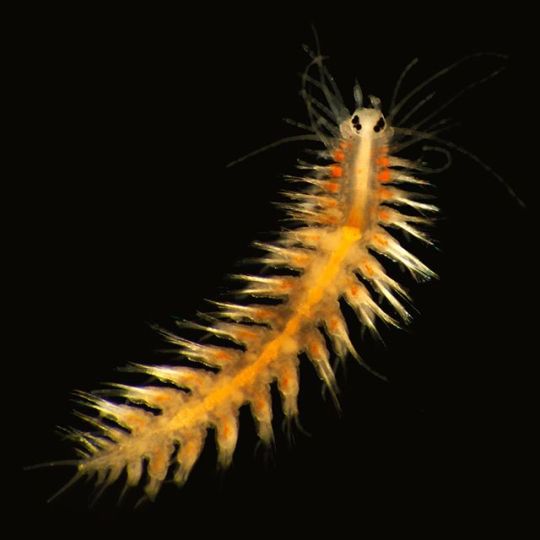
•Maerl Series (San Clemente Island)🔹Hesionidae contains some of the most beautiful of annelids and are named after the Trojan princess Hesione, was saved by Hercules from a sea monster and is later life may have been a cause of the Trojan War. Hesionid worms are predators and here we have a new species of Neogyptis from shallow water maerl (rhodolith beds) of San Clemente. This is a male who had alas spawned in the dish so you can see how full his body had been with sperm.🔹⠀⠀⠀⠀ 🦑⠀⠀⠀⠀ 🐙⠀⠀⠀⠀⠀⠀⠀⠀⠀⠀⠀ 🦐⠀⠀⠀⠀⠀⠀⠀⠀ 🦀⠀⠀⠀⠀⠀⠀⠀⠀⠀⠀⠀⠀⠀⠀⠀ 🦐⠀⠀⠀⠀⠀⠀⠀⠀ 🐙⠀⠀⠀ #Hesionidae #Hesione #Neogyptis #SanClementeIsland #California #maerl #annelid #worm #nameaspecies #polychaete #scrippsoceanography #scrippscollections #oceanography #microscopy #ucsd #ucsandiego⠀ — view on Instagram https://ift.tt/2YTaGXM
0 notes
Photo

•Maerl Series (San Clemente Island)🔹Hesionidae contains some of the most beautiful of annelids. This is apt as the name is derived from Hesione a mythical figure or figures. The most famous Hesione was saved by Hercules from a sea monster and is later life may have been a cause of the Trojan War. Hesionid worms are predators and here we have a new species of Neogyptis from shallow water maerl (rhodolith beds) of San Clemente. This is a female and you can see her two pairs of black eyes and the eggs filling her body cavity.🔹⠀⠀⠀⠀ 🦑⠀⠀⠀⠀ 🐙⠀⠀⠀⠀⠀⠀⠀⠀⠀⠀⠀ 🦐⠀⠀⠀⠀⠀⠀⠀⠀ 🦀⠀⠀⠀⠀⠀⠀⠀⠀⠀⠀⠀⠀⠀⠀⠀ 🦐⠀⠀⠀⠀⠀⠀⠀⠀ 🐙⠀⠀⠀ #Hesionidae #Hesione #Neogyptis #SanClementeIsland #California #maerl #annelid #worm #nameaspecies #polychaete #scrippsoceanography #scrippscollections #oceanography #microscopy #ucsd #ucsandiego⠀⠀ — view on Instagram https://ift.tt/2KysBKa
1 note
·
View note
Photo
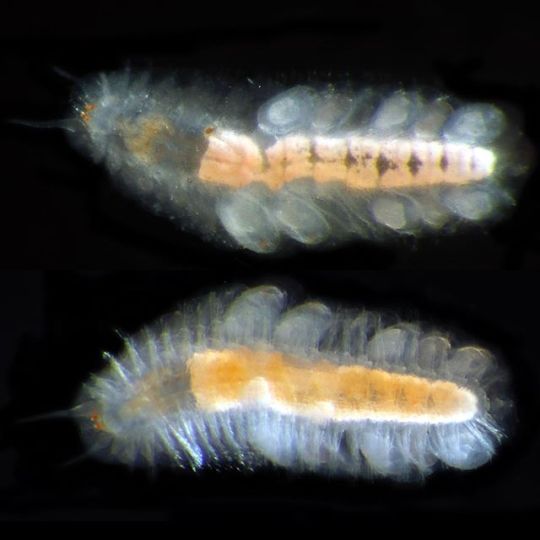
•Maerl Series (San Clemente Island)🔹 The maerl of southern California has proved to be a great habitat to look for unusual annelids. Here are dorsal and ventral (lower pic) views of what is very likely to be a species of sigalionid 'scaleworm' in the genus Laubierpholoe. These small worms, no more than 5 mm long, have two pairs of red eyes and otherwise look like fairly normal scaleworms. They are extraordinary though in that the females 'brood' their offspring in pouches on the underside of their scales. Here, this mother worm has 6 babies at various stages of development in her scales. Some of them are developed enough that you can see their little red eyes. They will hatch out as little juveniles and crawl away.🔹⠀⠀ •⠀⠀⠀⠀⠀⠀⠀⠀⠀⠀⠀⠀⠀ •⠀⠀⠀ •⠀⠀⠀ #Laubierpholoe #sigalionid #Sigalionidae #SanClementeIsland #scaleworm #brooder #ovoviviparous #California #maerl #annelid #worm #polychaete #scrippsoceanography #scrippscollections #oceanography — view on Instagram https://ift.tt/2KkKH3i
1 note
·
View note
Photo

•Maerl Series (San Clemente Island)🔹Lacydonia is a small group of annelids with only 12 accepted species from around the world. They are closely related to paddle worms (Phyllodocidae), but dont have the expanded petal-like cirri covering their backs they way that group does. Here a large female Lacydonia, full of eggs, is flanked by two males. Only one Lacydonia is named from off California, or even the eastern Pacific, and that was from deep water off San Francisco. This one from shallow water maerl (rhodolith beds) appears to be a new species.🔹⠀⠀⠀ •⠀⠀⠀⠀⠀⠀⠀⠀⠀⠀⠀⠀⠀⠀⠀ •⠀⠀⠀⠀ •⠀⠀⠀⠀ #Lacydonia #SanClementeIsland #California #maerl #annelid #worm #nameaspecies #polychaete #scrippsoceanography #scrippscollections #oceanography #microscopy #ucsd #ucsandiego⠀ — view on Instagram https://ift.tt/2ZBqECU
1 note
·
View note
Photo
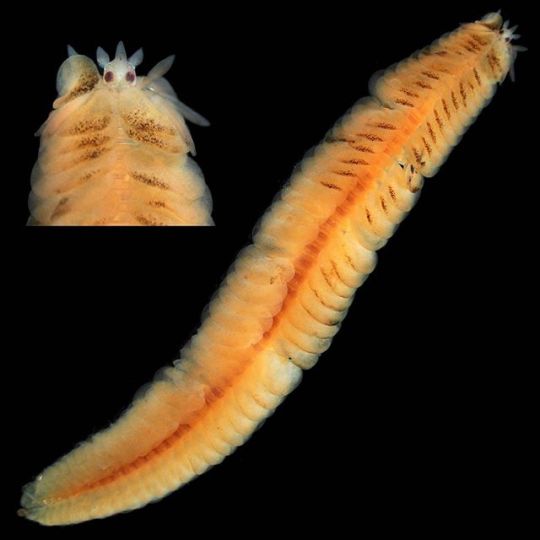
•Maerl Series (San Clemente Island)🔹 The maerl of southern California is a great habitat to look for unusual invertebrates. Here is what is a phyllodocid called Notophyllum tectum, which was described in 1919 by Ralph Chamberlin in a paper called " New polychaetous annelids from Laguna Beach, California. " This worm was about 2 cm long and, as per its other paddeworm relatives, was probably hunting for small crustaceans and other worms in the maerl .🔹⠀⠀ •⠀⠀⠀⠀⠀⠀⠀⠀⠀⠀⠀⠀⠀ •⠀⠀⠀ •⠀⠀⠀ #Notophyllum #phyllodocid #paddle worm #Phyllodocidae #SanClementeIsland #California #maerl #annelid #worm #polychaete #scrippsoceanography #scrippscollections #oceanography — view on Instagram https://ift.tt/2KnZcCm
1 note
·
View note
Photo

•Maerl Series (San Clemente Island)🔹⠀ Here is an oral (or lower) view of Brissus obesus, a heart urchin described in 1867 from Mexico and now newly recorded for southern California. This heart urchin was easily the largest animals in the maerl, reaching 4-6 cm in length. The red objects you can see are its tube feet that are radiating away from the mouth opening.⠀ 🔹⠀⠀⠀⠀⠀⠀⠀⠀⠀⠀⠀⠀⠀⠀⠀ 🦑⠀⠀⠀ 🐙⠀⠀⠀⠀⠀⠀⠀⠀⠀⠀ 🦐⠀⠀⠀⠀⠀⠀⠀ 🦀⠀⠀⠀⠀⠀⠀⠀⠀⠀⠀⠀⠀⠀⠀ 🦐⠀⠀⠀⠀⠀⠀⠀ 🐙⠀⠀⠀ #Brissus #Echinoidea #SanClementeIsland #California #maerl #seaurchin #hearturchin #scrippsoceanography #scrippscollections #oceanography #macro #ucsd #ucsandiego⠀⠀⠀ — view on Instagram https://ift.tt/31iiBeN
1 note
·
View note
Photo

•Maerl Series (San Clemente Island)🔹⠀ Brissus obesus is a species of heart urchin that was first described in 1867 by Addison Verrill. It was found in the Gulf of California and is normally only known from that region and south to Panama. We have have several of our own local heart urchins, so it was somewhat surprising to find quire a few of these in our maerl samples. There were easily the largest animals in the maerl, reaching 4-6 cm in length. Rich Mooi, an echinoid expert at the CalAcad https://www.calacademy.org/learn-explore/science-heroes/rich-mooi⠀ was pretty sure this a new record for California and may be another species heading north with our warming oceans....🔹⠀⠀⠀⠀⠀⠀⠀⠀⠀⠀⠀⠀⠀⠀⠀ 🦑⠀⠀⠀ 🐙⠀⠀⠀⠀⠀⠀⠀⠀⠀⠀ 🦐⠀⠀⠀⠀⠀⠀⠀ 🦀⠀⠀⠀⠀⠀⠀⠀⠀⠀⠀⠀⠀⠀⠀ 🦐⠀⠀⠀⠀⠀⠀⠀ 🐙⠀⠀⠀ #Brissus #Echinoidea #SanClementeIsland #California #maerl #seaurchin #hearturchin #scrippsoceanography #scrippscollections #oceanography #macro #ucsd #ucsandiego⠀⠀⠀⠀ — view on Instagram https://ift.tt/2OD0ej9
0 notes
Photo

•Maerl Series (San Clemente Island)🔹One group of chrysopetalids have more spiny chaetae rather than paleae. They still have the shiny gold aspect though, which gave rise to the name chrysopetalid (Greek chrysos for gold and petalon for leaf or petal). An example is Dysponetus populonectens, which we described in 2012 from a kelp holdfast from La Jolla. Goes to show how many new species are still to be found in the sea if this 1 cm beauty, from right offshore one of the oldest oceanographic institutions in the US, had gone unnoticed. The name populonectens is the Latin version of 'connecting people', the slogan of the company Nokia. We have a Name-A-Species program at Scripps that supports our Collections and research into biodiversity and Nokia was an early sponsor. It was a pleasant surprise to find Dysponetus populonectens in the maerl off San Clemente.🔹⠀⠀ •⠀⠀⠀⠀⠀⠀⠀⠀⠀⠀⠀⠀⠀⠀ •⠀⠀⠀ •⠀⠀⠀ #Dysponetus #Chrysopetalidae #SanClementeIsland #California #maerl #annelid #worm #nameaspecies #polychaete #scrippsoceanography #scrippscollections #oceanography #microscopy #ucsd #ucsandiego⠀ — view on Instagram https://ift.tt/2Yywaox
0 notes
Photo

•Maerl Series (San Clemente Island)🔹The maerl (rhodolith beds) off San Clemente Island provide a safe place for larvae and juveniles of larger creatures to grow up before they venture out onto the surface. Here are lateral and 'ventral' views of Apostichopus parvimensis, the California Warty Sea Cucumber. The mouth and tentacles are on the upper side of the picture. It was only 1 cm long, but as an adult reach well over 40 cm in length. We confirmed its identify via DNA sequencing. You can see the tiny ossicles shining in the body wall. These represent the reduced skeleton that most sea cucumbers have relative to the hard tests of their close relatives, the sea urchins. The tube feet it crawls with on the lower body surface. This species was named by Hubert Clark in 1913 in a paper called "Echinoderms from Lower California, with descriptions of new species. "🔹⠀ ⠀⠀ 🦑⠀⠀⠀⠀ 🐙⠀⠀⠀⠀⠀⠀⠀⠀⠀⠀⠀ 🦐⠀⠀⠀⠀⠀⠀⠀⠀ 🦀⠀⠀⠀⠀⠀⠀⠀⠀⠀⠀⠀⠀⠀⠀⠀ 🦐⠀⠀⠀⠀⠀⠀⠀⠀ 🐙⠀⠀⠀⠀⠀⠀ #Apostichopus #Holothuroidea #SanClementeIsland #California #maerl #annelid #seacucumber #echinoderm #scrippsoceanography #scrippscollections #oceanography #microscopy #ucsd #ucsandiego⠀ ⠀ ⠀⠀⠀ — view on Instagram https://ift.tt/2MyDezn
0 notes
Photo
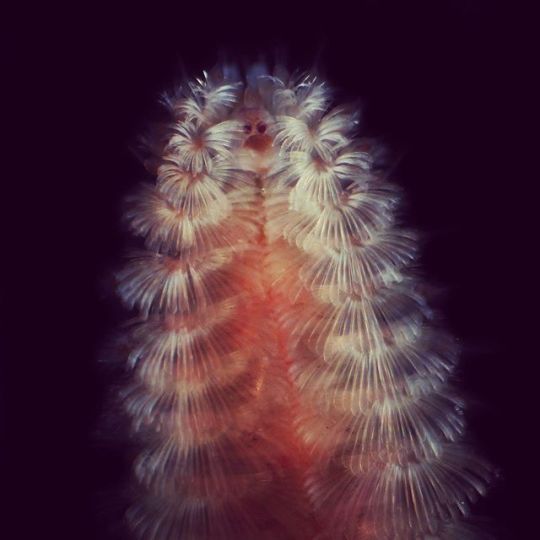
•Maerl Series (San Clemente Island)🔹Chrysopetalid means 'golden petals' and refers to the delicate chaetal fans that many of these worms have over the dorsal surface. This is the anterior end of Chrysopetalum occidentale, one of the most common animals we find in the maerl off San Clemente Island. You can see its pair of red eyes and the delicate array of chitinous chaetae (called paleae) that flare out over its back, presumably for protection.🔹⠀ 🦑⠀⠀⠀ 🐙⠀⠀⠀⠀⠀⠀⠀⠀⠀⠀ 🦐⠀⠀⠀⠀⠀⠀⠀ 🦀⠀⠀⠀⠀⠀⠀⠀⠀⠀⠀⠀⠀⠀⠀ 🦐⠀⠀⠀⠀⠀⠀⠀ 🐙⠀⠀⠀⠀⠀ #Chrysopetalum #Chrysopetalidae #SanClementeIsland #California #maerl #annelid #worm #polychaete #scrippsoceanography #scrippscollections #oceanography #microscopy #ucsd #ucsandiego — view on Instagram https://ift.tt/2K55MyQ
0 notes
Photo
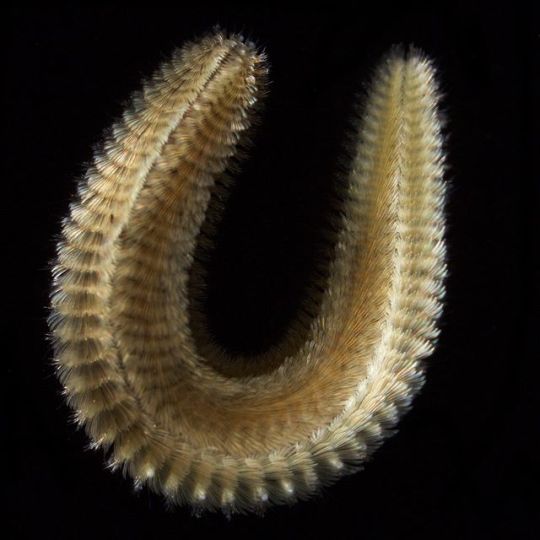
•Maerl Series (San Clemente Island)🔹Chrysopetalid means 'golden petals' and refers to the delicate chaetal fans that many of these worms have over the dorsal surface. This lovely example is Chrysopetalum occidentale, which is common along the southern California coast and was named in 1897, by Herbert Johnson, from specimens from Los Angeles. Up to 1 cm long, Chrysopetalum occidentale is one of the most common animals we find in the maerl off San Clemente.🔹⠀ •⠀⠀⠀⠀⠀⠀⠀⠀⠀⠀⠀⠀⠀ •⠀⠀ •⠀⠀ #Chrysopetalum #Chrysopetalidae #SanClementeIsland #California #maerl #annelid #worm #polychaete #scrippsoceanography #scrippscollections #oceanography #microscopy #ucsd #ucsandiego — view on Instagram https://ift.tt/2Y7n9aC
1 note
·
View note
Photo

drverm⠀ •Maerl Series (San Clemente Island)🔹Navanax inermi is a large predatory sea slug species. Navanax is not a nudibranch; it belongs to a group called head shield slugs and snails (Cephalaspidea). This one is a juvenile, only 1 cm long, living in the maerl (rhodolith bed) and no doubt creating havoc as it eats all the other denizens of this habitat. Navanax inermi was named by James Cooper in 1862⠀ https://en.wikipedia.org/wiki/James_Graham_Cooper🔹⠀⠀ 🦑⠀⠀ 🐙⠀⠀⠀⠀⠀⠀⠀⠀⠀ 🦐⠀⠀⠀⠀⠀⠀ 🦀⠀⠀⠀⠀⠀⠀⠀⠀⠀⠀⠀⠀⠀ 🦐⠀⠀⠀⠀⠀⠀ 🐙⠀⠀⠀⠀⠀⠀⠀⠀⠀ #Navanax #SanClementeIsland #California #maerl #mollusc #gastropod #cephalaspidea #scrippsoceanography #scrippscollections #oceanography #microscopy #ucsd #ucsandiego⠀ — view on Instagram https://ift.tt/2ZdOPY4
0 notes
Photo

•Maerl Series (San Clemente Island)🔹Polygordius are bizarre annelid worms. At first glance look like large nematodes as they writhe around. They were named by Anton Schneider in 1868, who erroneously thought they were indeed nematodes. Subsequently, Polygordius was proposed to represent the most primitive of annelids and were the first group assigned to a now disregarded group, Archiannelida. They like to live in gravelly sands with lots of spaces, and so maerl (rhodolith beds) is ideal for them. Here the head is to the lower right and has two small appendages. There is a head close up on the lower left, also showing the amazing iridescence of the cuticle. Polygordius lack any chaetae and superficially appear to not be segmented, leading to the idea that they were some sort of 'archiannelid'.🔹⠀ 🦑⠀ 🐙⠀⠀⠀⠀⠀⠀⠀⠀ 🦐⠀⠀⠀⠀⠀ 🦀⠀⠀⠀⠀⠀⠀⠀⠀⠀⠀⠀⠀ 🦐⠀⠀⠀⠀⠀ 🐙⠀⠀⠀⠀⠀⠀⠀⠀ #Polygordius #SanClementeIsland #California #maerl #annelid #worm #polychaete #scrippsoceanography #scrippscollections #oceanography #microscopy #ucsd #ucsandiego — view on Instagram https://ift.tt/2MlTBiD
0 notes
Photo
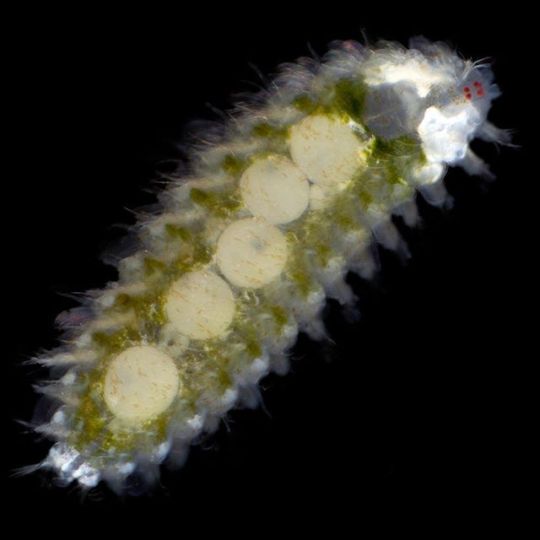
•Maerl Series (San Clemente Island)🔹 The maerl of southern California is a great habitat to look for interstitial creatures and for the last few years this has been collected for us by the awesome Phil Zerofski (https://ift.tt/2GjOjQM). One of the new species we have found in these samples is a tiny chrysopetalid annelid. Chrysopetalid means 'golden petals' and refers to the delicate chaetal fans that many of these worms have over the dorsal surface. This new species will be named after Phil as zerofskii and in the genus Hyalopale. Other authors in this study are @spinelessguy and it is of course led by the queen of Chrysopetalidae, Charlotte Watson. In this picture you can see the relatively large eggs in the body and she only has 5. Interestingly we found about 10 specimens of this new species and all proved to be females, the males remain unknown.🔹⠀⠀⠀ •⠀⠀⠀⠀⠀⠀⠀⠀⠀⠀⠀⠀⠀⠀⠀ •⠀⠀⠀⠀ •⠀⠀⠀⠀ #Chrysopetalidae #Hyalopale #SanClementeIsland #California #maerl #annelid #worm #polychaete #scrippsoceanography #scrippscollections #oceanography #microscopy #ucsd #ucsandiego — view on Instagram https://ift.tt/2YcXc9W
0 notes
Photo

•Maerl Series (San Clemente Island)🔹 The maerl of southern California is a great habitat to look for interstitial creatures and for the last few years this has been collected for us by the awesome Phil Zerofski (https://ift.tt/2GjOjQM). One of the new species we have found in these samples is a tiny chrysopetalid annelid. Chrysopetalid means 'golden petals' and refers to the delicate chaetal fans that many of these worms have over the dorsal surface. This new species will be named after Phil as zerofskii and in the genus Hyalopale. Other authors this study are @spinelessguy and it is led by Charlotte Watson. 🔹⠀⠀ •⠀⠀⠀⠀⠀⠀⠀⠀⠀⠀⠀⠀⠀⠀ •⠀⠀⠀ •⠀⠀⠀ #Chrysopetalidae #Hyalopale #SanClementeIsland #California #maerl #annelid #worm #polychaete #scrippsoceanography #scrippscollections #oceanography #microscopy #ucsd #ucsandiego⠀ — view on Instagram https://ift.tt/2JTeCQ4
0 notes
Photo

•Maerl Series (San Clemente Island)🔹 The maerl of southern California is a great habitat to look for interstitial creatures. Protodrilidae, which means 'first worm' was named by Berthold Hatschek in 1888, and was erroneously thought by the author and many subsequent worm workers, to represent what the original annelids looked like. They like to live in gravelly sands with lots of spaces and maerl is ideal for them. Here is a male (left) and female (right) of a possibly new protodrilid in the genus Lindrilus. They have a little pair of palps on their head and the pharynx is bright red. Protodrilids lack any chaetae and appear to not be segmented, leading to the idea that they were some sort of 'archiannelid'. In fact, they have become simplified.🔹⠀ •⠀⠀⠀⠀⠀⠀⠀⠀⠀⠀⠀⠀⠀ •⠀⠀ •⠀⠀ #Protodrilidae #Lindrilus #SanClementeIsland #California #maerl #annelid #worm #polychaete #scrippsoceanography #scrippscollections #oceanography #microscopy #ucsd #ucsandiego⠀ — view on Instagram https://ift.tt/32MdAg0
0 notes
Photo
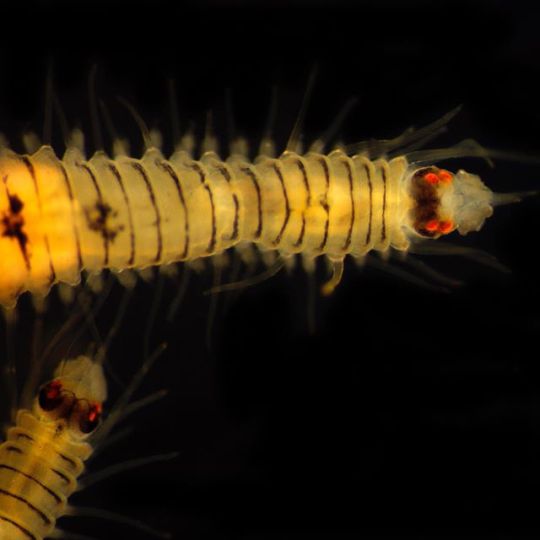
•Maerl Series (San Clemente Island)🔹 The maerl of southern California is a great habitat to look for unusual invertebrate. Here is a pair of syllids, Odontosyllis phosphorea. In summer they transform into 'epitokes' and on a full moon will swim up to the surface to find a mate. Once with a partner, they will do a 'nuptial dance' and as their gametes stream out they glow a lovely green. This species was described in 1909 from collections made at Catalina Island, off the California coast. Percy Moore, who described it, was given the specimen with a label in the bottle that read 'Phosphorescent annelids caught at the surface, Avalon Bay'. It was collected by the ship USS Albatross, thought by some to be the first ship built for marine research.🔹⠀ •⠀⠀⠀⠀⠀⠀⠀⠀⠀⠀⠀⠀⠀ •⠀⠀ •⠀⠀ #Odontosyllis #phosphorescence #syllid #Syllidae #SanClementeIsland #California #maerl #annelid #worm #polychaete #glowworm #scrippsoceanography #scrippscollections #oceanography #microscopy #ucsd #ucsandiego — view on Instagram https://ift.tt/2LFGeKj
0 notes